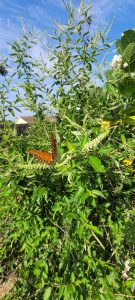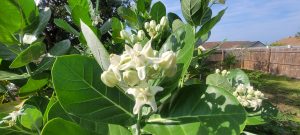
One of my all time favorite plants in my backyard are my sweet almond bushes. I first discovered these plants as I wandered around a local lawn and garden center, drawn to their wonderful almond scent emanating from its small, white flower clusters. They are one of two plants that I added with pollinators in mind, the other being a Giant Milkweed.

This sweet almond bush is a fast growing, fragrant shrub does well in part shade to full sun, and requires a decent amount of water in the first couple years after planting. Without sufficient water, you will notice it doesn’t produce flowers and the leaves will start to curl around the edges. Now that my sweet almond bushes have had a few years to get acclimated to the area. The are highly drought tolerant plants, and do well with summer rainfall or 1-2x weekly waterings.
This is a plant I would recommend using if you are interested in having a variety of pollinator visitors. Butterflies, bumblebees, honeybees, and various wasps often pay a visit to these bushes, and one of the more interesting visitors I’ve observed has been scoliid wasps.



If you decide to plant a sweet almond bush, be sure to give it plenty of space, as it can grow 6-12’ high, and is fast growing. Its fragrant flowers appear from March-November.
Additional Resources:
https://ffl.ifas.ufl.edu/bees/plants/Details/21
 1
1
